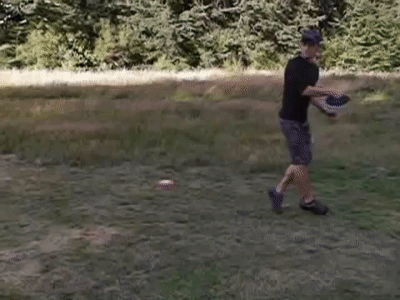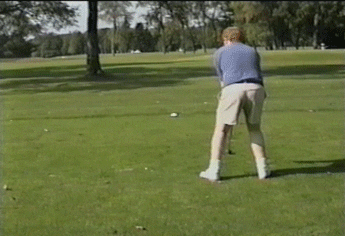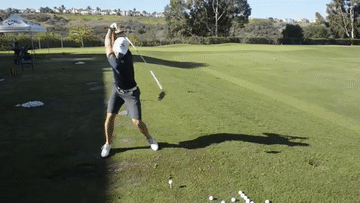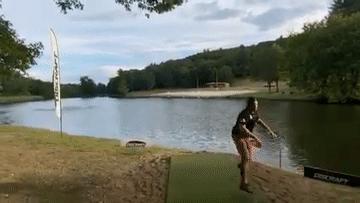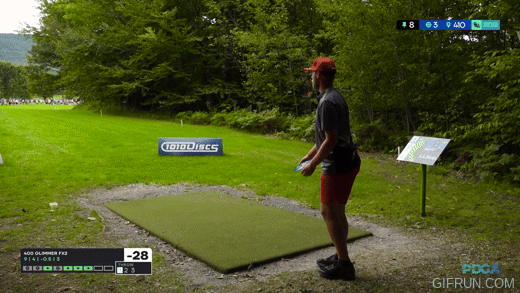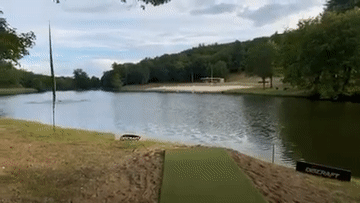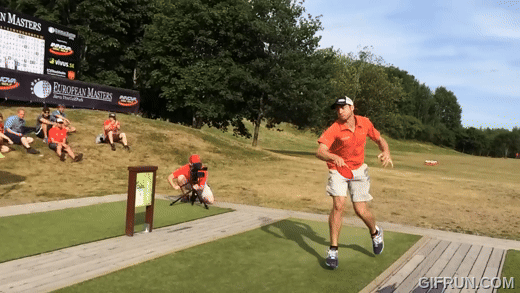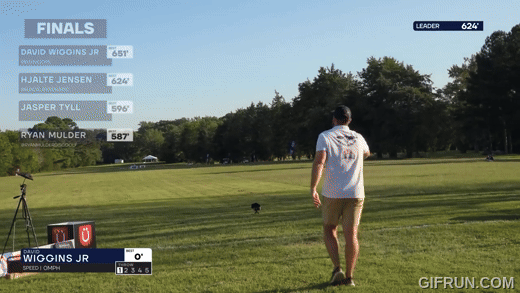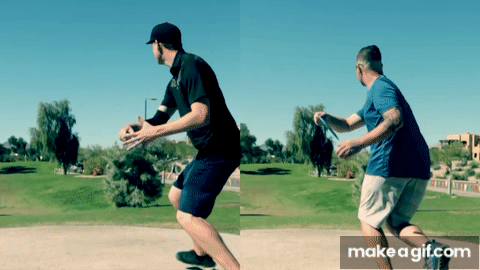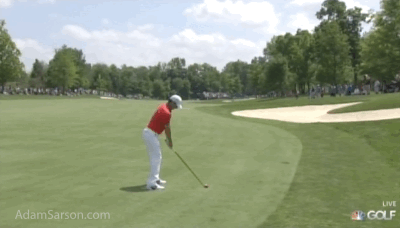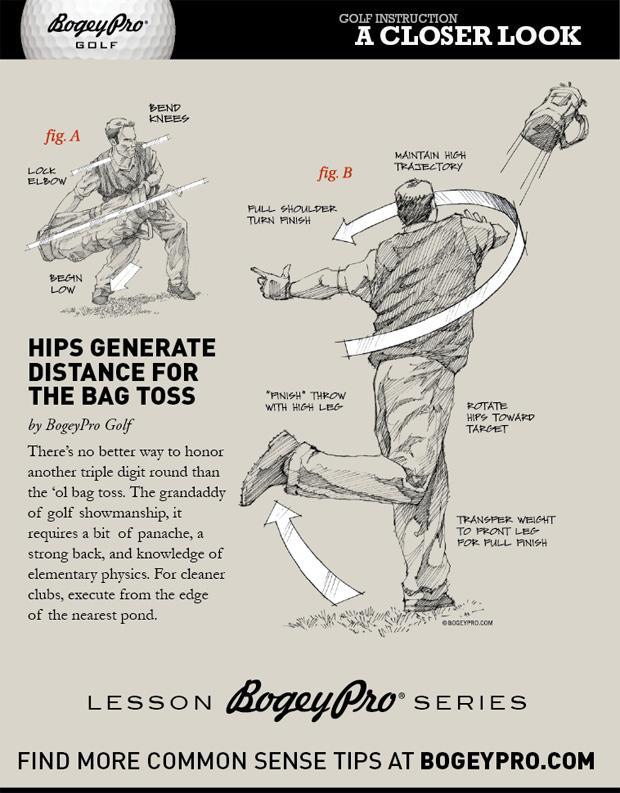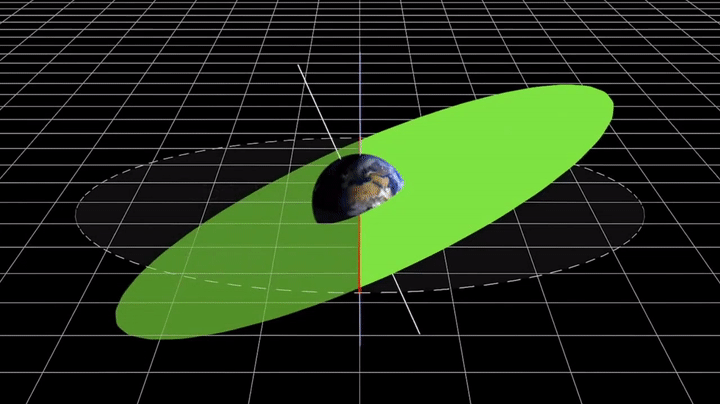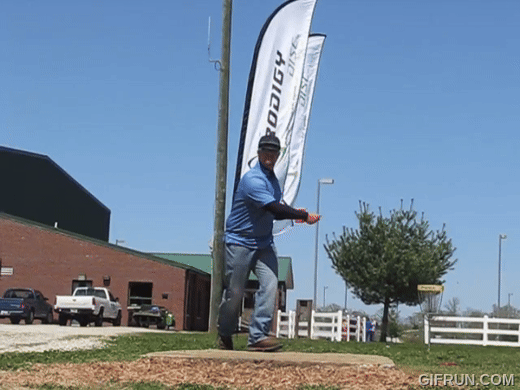Brychanus
* Ace Member *
TL;DR: If you're already an elite athlete and top 50 thrower on tour, you're probably doing this well enough. Congratulations! If not, maybe there's a nugget or two in here you will find instructive, but it's mostly a form theory thread. "Just do it" if you actually want to learn and Understand it.
Tilted Axes, Spirals, and Dynamic Balance
There are a few form concepts that commonly appear to challenge developing players. A subset of them are either (1) controversial or (2) so hard to learn that they eventually cause me to centralize some thoughts and examples.
In addition to the Swing Plane (and I would add, entire form) not Being Flat, the concepts of dynamic balance, tilted axes, and tilted spirals appear frequently on this forum and in my estimation, few other places in Disc Golf instruction or mechanics chatter. I think that one of the reasons is that like the "center of mass (CoM)" or "center of gravity," balance is a theoretical construct. We cannot observe it directly on camera. We can only observe its causes and effects. Even more deeply than the CoM, balance is an incredibly complex interaction between our brains and bodies, under the influence of gravity. Thus, dynamic balance is more fundamental, and the motion of the theoretical CoM is best understood in its context.
Learning proper dynamic balance is perhaps the most fundamental part of the entire move that almost no one talks about. I find this dichotomy fascinating, and after more than two years "knowing" it and just one or two months starting to "understand" part of it, I figured I would do my best again in pictures and words to say something about something you just have to learn, feel and do. If you already Understand it, you probably don't need to Know much more about it. But for the countless players who don't, you might Understand it better if you first Know it better.
I never want you to see form the same way again, and I always want it to encode the concept of dynamic balance just like every other advanced motion humans can learn. If I am wrong and somehow form doesn't involve dynamic balance like every other advanced motion humans perform, I will eat one tenth of my least favorite hat.

Advanced baseball players Understand the tilted axis. So do skiiers, skaters, half pipe skateboarders, golfers, and Pro Tour disc golfers.
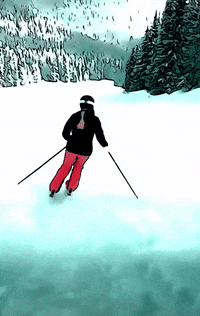
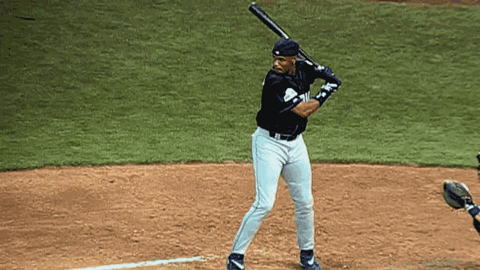
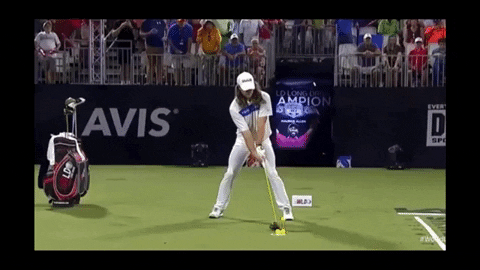
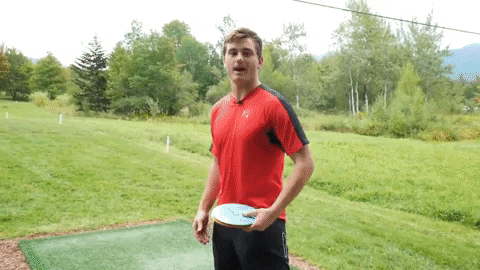
Movement occurs in three primary dimensions (Vertical, North-South, and West-East) over the fouth dimension (time). Fortunately, the first one is "solved" if you are standing on the planet Earth.
Dynamic balance can be sketched in the second two dimensions in the context of the first (vertical) and fourth (time). Stillframes remove the fourth dimension, meaning that they isolate balance at a given moment. I will take the stillframe approach in this first post, and my hope is that this thread will expand to give people plenty of four-dimensional reference points. The head is always balanced relative to the feet in advanced movement and is a fundamental aspect of posture control [see e.g.: 1 2 3].
For simplicity I will start by talking about what happens between the drive step (X-step) and the plant step, because the move often becomes more varied and sophisticated before that as I will show later.
Vertical
Gravity pulls you down (and you pull with a much less significant but present force on the Earth). Yay! We're done with this dimension.

The next two dimensions are expressed cardinally along the move and teepad in an idealized case where the target is directly ahead of the tee ("North") just because it's how it's frequently described around DGCR:

North-South
I lead with this dimension because (1) it is more aligned with the overall commitment of motion and the "center of mass" down the tee and (2) I am increasingly convinced many players literally cannot perceive what someone like Sidewinder or I (and he still more than me) do in form critiques because they are missing the invisible concept of balance. Your perception improves by both Knowing and Understanding it. Moreover, I think moving in the South-to-North direction athletically in the backhand direction while throwing a thing easily distract the eye from the balance problem because there is so much going on in the X-step. Best shown in pictures and not in words. You aim to be in dynamic Tilted balance through backswing see Ezra and Sidewinder in the following image) to swing, whereas I think many people only notice the planted side (all players below).

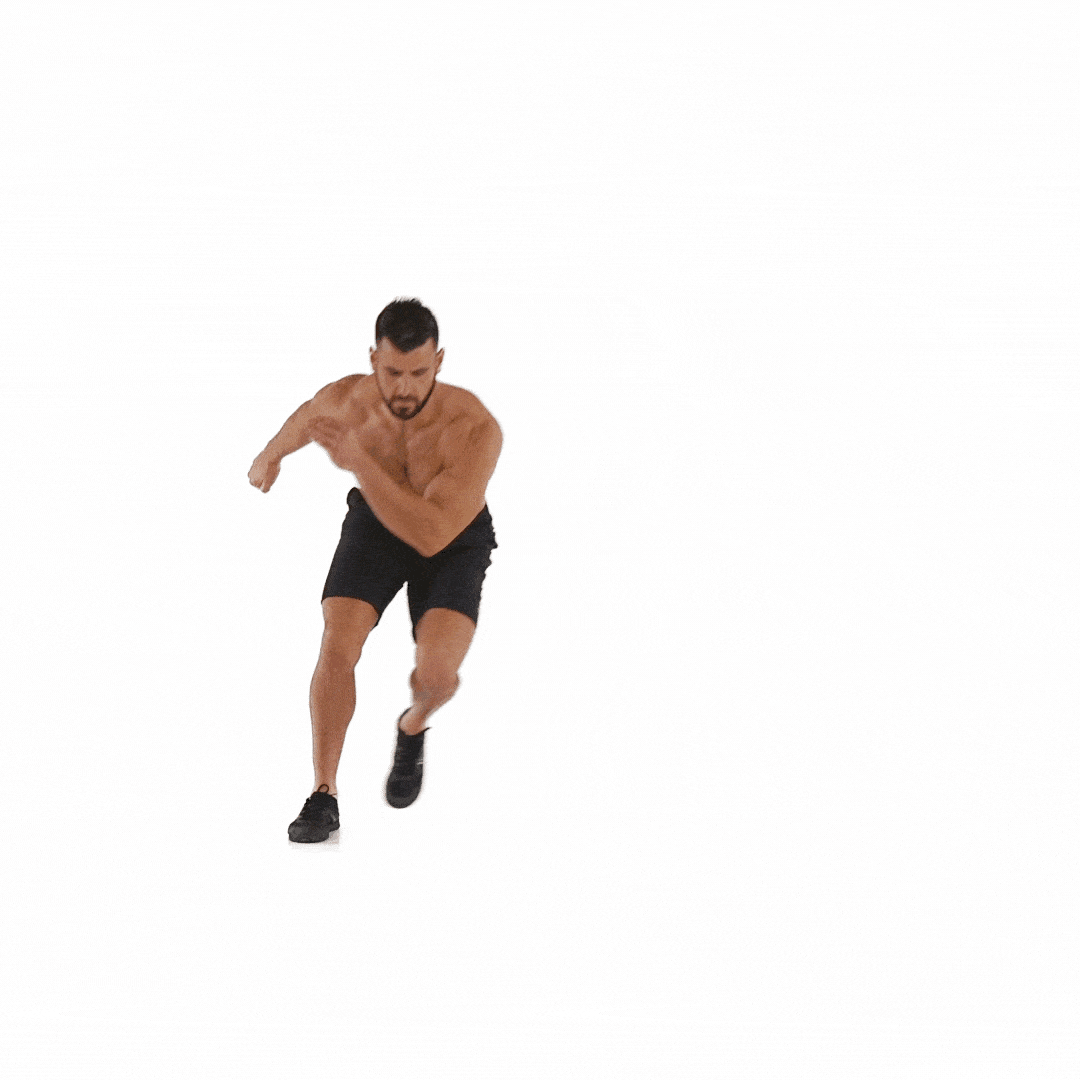
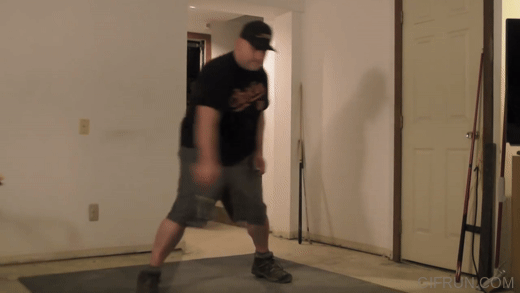
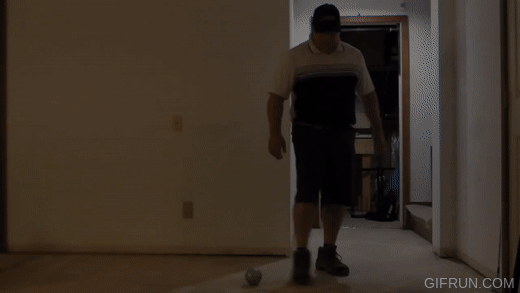
Exercise: these players are all in tilted balance head to foot. Can you draw the imaginary lines? Where do you think their balance is head-to-foot at this moment?

Hints: here are examples of people in tilted dynamic balance versus people who are not (emphasizing the North-South direction, which is always correlated with West-East problems because you are either completely in dynamic balance or you are not). These errors come in many forms, but almost always involve moves that are (1) more vertically spinning without a tilted axis and therefore (2) trapping the CoM between the feet rather than flowing into follow through, and (3) often tipping into the plant from the "power" or "horse stance" or one of its variants. Please remember that my intent is never to personally criticize a person, but to point out instructive examples. I can point out or have had pointed out countless errors in my own movement. Bringing it all out into the open is how progress occurs.

Exercise: how can Weck & Sidewinder's balance be the "same" from head to foot even though the posture of the move differs?
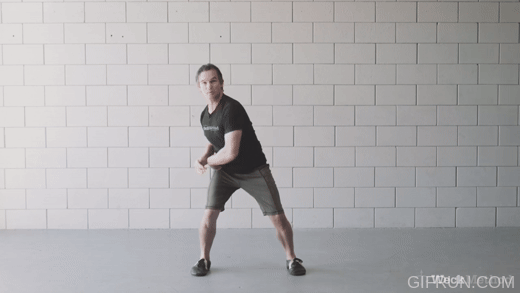
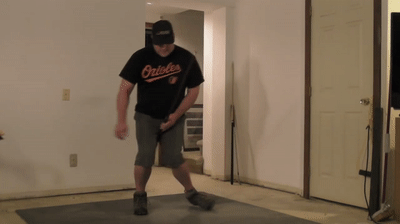
Drills (seabas22):
-Turbo Encabulator
-Double Dragon/Can Can Drill
-Kick the Can or Ball.
-Tilted Twirl Star Burst
East-West
Somehow the basic concept of walking or running sideways in athletic posture and balance says it all, but this dimension is also just as easily misunderstood because it gets harder and harder with more momentum down the tee as the backswing elongates, and there are varying stride patterns that advanced players use going into the plant that distract curious eyes.
Notice in SW22 moving down the hall there is West (wall in front of him) to East (wall behind him) movement as his spine sways over his feet. The CoM moves more than some instructors suggest in the West direction. When he lands on the front foot (the crush), the CoM is stacked vertically over the plant foot. You do the equivalent action when walking forward, but it is much smaller than moving sideways and you do not have to think about it!
The balance point that is often missed: when he crosses behind, the CoM moves back but doesn't appear to stack vertically over the rear foot, but keep in mind that the backswing/X-/crossover step loads by allowing the rear hip to "cock" up and away from the target, setting up the torque force that you want to commit to the shot when you plant, and the pressure doesn't often land all the way into the back heel the way it does when you plant to swing. The imaginary line I drew on SW22 from head to foot represents the dynamic balance through the CoM in the backswing/crossover step.

Exercise: can you "see" this balance pattern moving back and forth? What about the movement in the CoM?
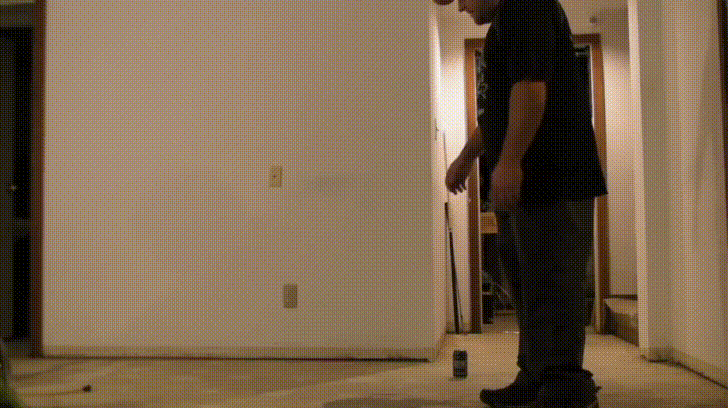
Drills:
-Run like above. Really! It's no joke. Run 100 yards down a line on a football field a few times in athletic posture. It will help you Understand. Get posture input if you're not an NFL linebacker.
Interim Conclusion:
When you combine these vertical, North-South, and West-East dynamics in a way your body can manage, you get something like these (diagonal camera angle chosen on purpose.
Exercise: basis of the Tilted Spiral- how do the combined North-South and West-East tilted axes in each player cause this similar movement pattern to emerge?).
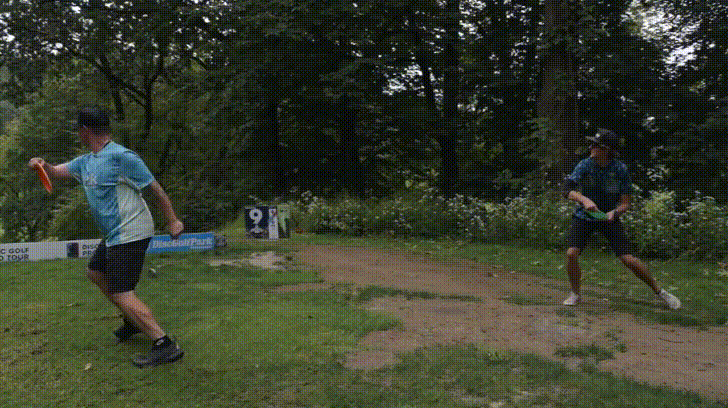
Tilted Axes, Spirals, and Dynamic Balance
There are a few form concepts that commonly appear to challenge developing players. A subset of them are either (1) controversial or (2) so hard to learn that they eventually cause me to centralize some thoughts and examples.
In addition to the Swing Plane (and I would add, entire form) not Being Flat, the concepts of dynamic balance, tilted axes, and tilted spirals appear frequently on this forum and in my estimation, few other places in Disc Golf instruction or mechanics chatter. I think that one of the reasons is that like the "center of mass (CoM)" or "center of gravity," balance is a theoretical construct. We cannot observe it directly on camera. We can only observe its causes and effects. Even more deeply than the CoM, balance is an incredibly complex interaction between our brains and bodies, under the influence of gravity. Thus, dynamic balance is more fundamental, and the motion of the theoretical CoM is best understood in its context.
Learning proper dynamic balance is perhaps the most fundamental part of the entire move that almost no one talks about. I find this dichotomy fascinating, and after more than two years "knowing" it and just one or two months starting to "understand" part of it, I figured I would do my best again in pictures and words to say something about something you just have to learn, feel and do. If you already Understand it, you probably don't need to Know much more about it. But for the countless players who don't, you might Understand it better if you first Know it better.
I never want you to see form the same way again, and I always want it to encode the concept of dynamic balance just like every other advanced motion humans can learn. If I am wrong and somehow form doesn't involve dynamic balance like every other advanced motion humans perform, I will eat one tenth of my least favorite hat.

Advanced baseball players Understand the tilted axis. So do skiiers, skaters, half pipe skateboarders, golfers, and Pro Tour disc golfers.




Movement occurs in three primary dimensions (Vertical, North-South, and West-East) over the fouth dimension (time). Fortunately, the first one is "solved" if you are standing on the planet Earth.
Dynamic balance can be sketched in the second two dimensions in the context of the first (vertical) and fourth (time). Stillframes remove the fourth dimension, meaning that they isolate balance at a given moment. I will take the stillframe approach in this first post, and my hope is that this thread will expand to give people plenty of four-dimensional reference points. The head is always balanced relative to the feet in advanced movement and is a fundamental aspect of posture control [see e.g.: 1 2 3].
For simplicity I will start by talking about what happens between the drive step (X-step) and the plant step, because the move often becomes more varied and sophisticated before that as I will show later.
Vertical
Gravity pulls you down (and you pull with a much less significant but present force on the Earth). Yay! We're done with this dimension.

The next two dimensions are expressed cardinally along the move and teepad in an idealized case where the target is directly ahead of the tee ("North") just because it's how it's frequently described around DGCR:

North-South
I lead with this dimension because (1) it is more aligned with the overall commitment of motion and the "center of mass" down the tee and (2) I am increasingly convinced many players literally cannot perceive what someone like Sidewinder or I (and he still more than me) do in form critiques because they are missing the invisible concept of balance. Your perception improves by both Knowing and Understanding it. Moreover, I think moving in the South-to-North direction athletically in the backhand direction while throwing a thing easily distract the eye from the balance problem because there is so much going on in the X-step. Best shown in pictures and not in words. You aim to be in dynamic Tilted balance through backswing see Ezra and Sidewinder in the following image) to swing, whereas I think many people only notice the planted side (all players below).




Exercise: these players are all in tilted balance head to foot. Can you draw the imaginary lines? Where do you think their balance is head-to-foot at this moment?

Hints: here are examples of people in tilted dynamic balance versus people who are not (emphasizing the North-South direction, which is always correlated with West-East problems because you are either completely in dynamic balance or you are not). These errors come in many forms, but almost always involve moves that are (1) more vertically spinning without a tilted axis and therefore (2) trapping the CoM between the feet rather than flowing into follow through, and (3) often tipping into the plant from the "power" or "horse stance" or one of its variants. Please remember that my intent is never to personally criticize a person, but to point out instructive examples. I can point out or have had pointed out countless errors in my own movement. Bringing it all out into the open is how progress occurs.

Exercise: how can Weck & Sidewinder's balance be the "same" from head to foot even though the posture of the move differs?


Drills (seabas22):
-Turbo Encabulator
-Double Dragon/Can Can Drill
-Kick the Can or Ball.
-Tilted Twirl Star Burst
East-West
Somehow the basic concept of walking or running sideways in athletic posture and balance says it all, but this dimension is also just as easily misunderstood because it gets harder and harder with more momentum down the tee as the backswing elongates, and there are varying stride patterns that advanced players use going into the plant that distract curious eyes.
Notice in SW22 moving down the hall there is West (wall in front of him) to East (wall behind him) movement as his spine sways over his feet. The CoM moves more than some instructors suggest in the West direction. When he lands on the front foot (the crush), the CoM is stacked vertically over the plant foot. You do the equivalent action when walking forward, but it is much smaller than moving sideways and you do not have to think about it!
The balance point that is often missed: when he crosses behind, the CoM moves back but doesn't appear to stack vertically over the rear foot, but keep in mind that the backswing/X-/crossover step loads by allowing the rear hip to "cock" up and away from the target, setting up the torque force that you want to commit to the shot when you plant, and the pressure doesn't often land all the way into the back heel the way it does when you plant to swing. The imaginary line I drew on SW22 from head to foot represents the dynamic balance through the CoM in the backswing/crossover step.

Exercise: can you "see" this balance pattern moving back and forth? What about the movement in the CoM?

Drills:
-Run like above. Really! It's no joke. Run 100 yards down a line on a football field a few times in athletic posture. It will help you Understand. Get posture input if you're not an NFL linebacker.
Interim Conclusion:
When you combine these vertical, North-South, and West-East dynamics in a way your body can manage, you get something like these (diagonal camera angle chosen on purpose.
Exercise: basis of the Tilted Spiral- how do the combined North-South and West-East tilted axes in each player cause this similar movement pattern to emerge?).

Attachments
Last edited:




